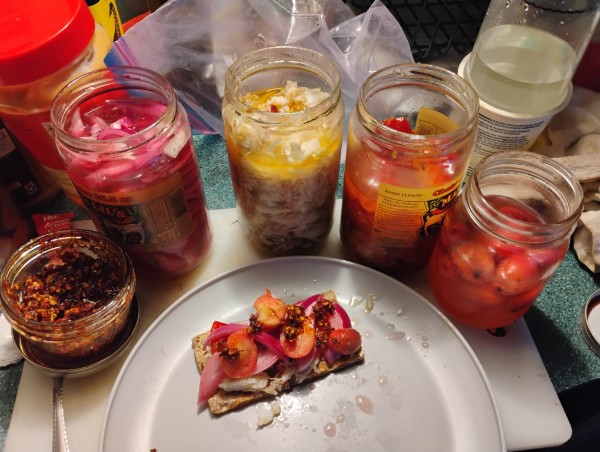I got invited to go crabbing with Brian and Randy. The weather roared all night with pouring rain. By daylight, it was just pouring rain, and when they picked me up mid-morning, the rain had let up. I’d already gone to a garage sale at Kevin and Brynn’s. I had pre-ordered a couple of his boat reels I didn’t need when he told me about his sale on the ferry ride over from Ketchikan, so I went to pick those up and see if I needed anything else. I found a few Alaskana books in the free pile.
We have to crab on the other side of the island now, as the sea otters have wiped out the crab on this side. About 10 years ago, you could set a pot on this side, right by the boat launch, in 40 feet of water and catch lots of crab. Now, you need to set below 200 feet, and even then, you might not get any. So, people on this side of the island drive across the island now to get crab. Sadly, it won’t be long til those crab are gone, too.
The problem is with the Marine Mammals Act, a federal law. Unfortunately, sea otters are considered a marine mammal, so are managed by the federal government, and not the state of Alaska, which regulates the rest of the furbearers like river otter, marten, mink, beaver and wolf. The main sticking point in the federal law is that sea otter fur, whose harvest is restricted to Native Alaskans, has to be worked in some way – like made into a blanket or a hat – before it can be sold. This is a bottleneck that severely restricts how many otters are taken each year, since the harvester can’t just sell green fur (fur that’s stretched and dried and sold to a fur buyer, who moves it to the people who tan it and make it into garments), but only a finished product. It would be like saying a commercial fishermen couldn’t sell his fish to a fish processor, but had to do all the fish processing and packaging themselves before they could sell the fish. Or that a farmer couldn’t sell his corn to local buyer, but had to get it into a can before they could sell it. So the fishers of dungeness crab, geoduck, sea urchins – all of which support a commercial fishery in the region, as well as for the rest of us for our own consumption -watch these resources consumed to such a low level by the the sea otters that, while they may not wipe out the entire populations, have them reduced to such a state that it’s not worth trying to harvest them anymore. Were the state managing them, I think we’d come up with a way to manage the sea otters to support a fur trade, a handicraft trade, and conserve the prey of the sea otter, but as we’ve seen in the past with our fisheries, the federal government functions more on process and perhaps a small powerful lobby, and less on what’s good for everybody. So, we adapt.
The day turned gorgeous, with the temperature in the 50’s and sunny when we launched the boat and headed for our pots. After we got the first pot in, I took on the jobs of baiting the bags for the next pots and tending the line hauler while the other two pulled the pots over the side and sorted the crab. The bait was fire red spawner coho salmon from the local hatchery. What a treasure this hatchery is to this side of the island. After decades of low returns and shoestring funding, the local aquaculture association took over the facility. Now the the returns can sometimes top 100,000 fish, which are shared by commercial trollers, charter fishers, and personal use harvest by residents.
When the crab pot comes aboard, females are universally returned, and males under a minimum size returned as well. Each of us can keep up to 20 crab. Randy and Brian handle the crab, with Randy using a handy measuring gauge to measure any crab that are not obviously legal. Nobody else is on the water with us, as the summer season has shut down. We have the waters all to ourselves.
Brian dropped me off at our place, and 7 crab from the tote filled my 5 gallon bucket. Dungeness crab are about the easiest seafood to catch, clean and cook, but one of the most tedious to extract what you’re after. You start out with a bucket full of critters, and when the shells are all shucked, and you eat your fill, you have a few bags of meat leftover to vacuum pack and freeze. Of course, it is dungeness crab, so it’s worth it.
I picked the crab and can report you get about a cup and a quarter of crab meat for each crab you pick. I ate some right out of the shell on a big bed of baby spinach greens with Mama Lil’s peppers, pickled red onions, a couple pickled crab apples from Roy’s, some Rik’s Devil Seed Chili oil (a new favorite), with some olive oil and balsamic vinegar dressing. That did the trick.
I had a bunch of pickling solution left from canning the crab apples, so I used some to pickle a couple red onions in a big Mama Lil’s jar. I filled another Mama Lil’s jar with crab and poured more pickling solution. This morning, I had a Wasa cracker with the crab, Mama Lil’s, the pickled onions, and Rik’s chili oil. That did the trick again.



